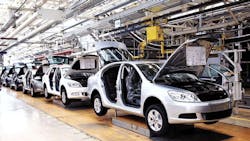Why Independent Cart Conveying is One Smart Move
Industrial robots are ubiquitous in automotive body shops and have enabled significant productivity gains over the past five decades. But the truth is, robotic technology is only as efficient as the conveyance systems transferring the car chassis. And in many automotive plants today, inefficient transfer systems are the major obstacle to improving performance.
The Problem with Conventional Conveyance Technology
Both throughput and flexibility are limited by conveyance technology common in automotive manufacturing. First, existing chain conveyors and roller-beds—and even skillet conveyors—typically run at fixed speeds, and often at fixed pitch. In an automotive assembly plant, this means the entire transfer system is continuously energized and running at the same speed. The carriers cannot accelerate, decelerate, and precisely position a specific chassis based on the completion of a process step.
While some conventional systems allow for variation in “pitch” or distance between the movers, in many situations that distance cannot be easily modified to accommodate multiple model types. In addition, traditional conveyers are based on complex, mechanical designs comprised of chains, belts, rollers, and gears—and sometime hundreds of wear components. These large, complicated solutions are not only difficult to modify, but also prone to maintenance and unscheduled downtime.
Perhaps most significantly, conventional friction-based transfer systems rely on rotary motor technology. Rotary motors intrinsically add inertia in linear applications, introduce multiple mechanical components, and limit improvements in speed and acceleration.
How Can Automakers Improve Efficiency in Conveyance Systems?
New advances in independent cart conveyance based on linear motor technology are enabling impressive performance gains. Linear motor technology allows conveyor modules to be configured end-to-end, creating an electromagnetic force to propel carriers much faster than traditional systems. Because of that, linear motors have no contacting or wear components, which translates into minimal maintenance. But linear motors are just part of the story.
Intelligent motion control is critical to improved productivity, flexibility, and sustainability. Using embedded position sensors and control software enables independent control over each carrier on the track. Accelerations, decelerations, velocities, and positions are programmable. Instead of moving at a fixed speed, vehicle body sections can quickly advance through robotic workstations as process steps are completed.
The result is a “pitchless” system that’s more energy efficient and 30% faster than conventional friction-based transfer systems. Since the speed boost allows for greater use of industrial robots and other process equipment, the overall system footprint is much smaller than traditional systems. Also, the highly configurable system can be adapted to handle multiple model types and can be expanded cost effectively, thanks to modularity.
Editor’s Note: The PULSE carrier conveyance system was introduced by Kuka Systems, an international supplier of automation systems for the automotive industry. Designed for automotive car body assembly lines, the conveyor utilizes linear synchronous motor technology from MagneMotion, a Rockwell Automation company.
Click here for information on independent cart technology.


